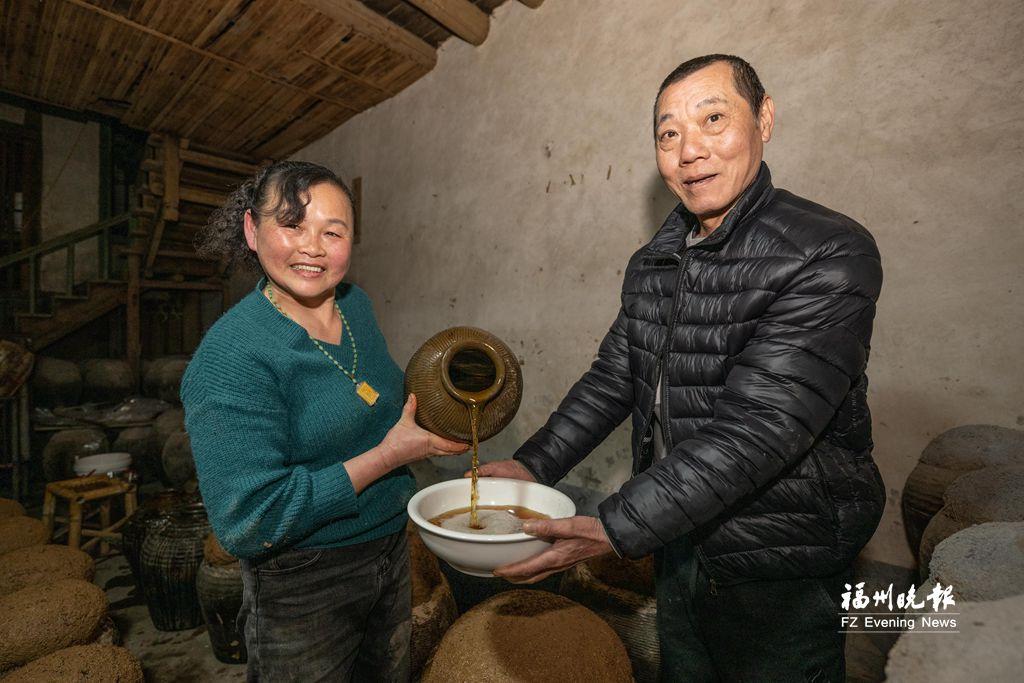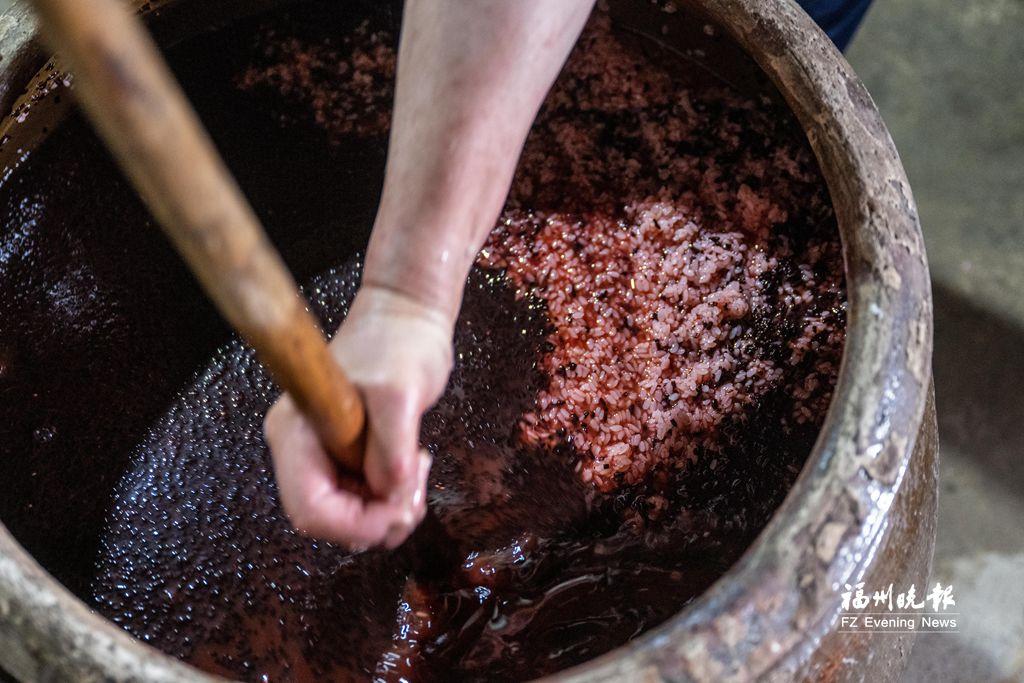Minhou Green & Red Wine: An Amber-Hued Drink Highlighting a Millennium of Elegance

Green & red wine is made using high-quality glutinous rice, red yeast rice, and pure water as its main ingredients.
In Minhou County, there is a type of wine with a bright, amber-like hue. It offers a rich, mellow aroma and a smooth, lingering finish when tasted. This is the renowned Minhou green & red wine.
With a history spanning a thousand years, this time-honored brew has captivated countless people with its distinctive charm. More than just a drink, it weaves together history, culture, and local tradition, serving as a heartfelt symbol of home for the people of Minhou.
An amber-hued wine, a legend spanning a thousand years
The history of green & red wine dates back to 202 BCE. According to legend, a local woman presented her homemade wine to Wu Zhu, the King of Minyue. The wine, with its captivating greenish-red hue and rich, mellow flavor, won the king’s heart with just one sip. From that moment, green & red wine transitioned from humble origins to royal favor, becoming the drink of choice for important occasions such as rituals and weddings at the Minyue royal palace.
After the “Yongjia Rebellion” during the Jin and Northern and Southern Dynasties, red yeast was introduced to Fujian by immigrants from the Central Plains, where the red yeast brewing technique took root. Minhou green & red wine, made with red yeast, originated in the Tang Dynasty and gained popularity during the Song Dynasty. It is celebrated as the “authentic Min-style yellow wine,” renowned for its intricate brewing process, rich and mellow flavor, and high nutritional value.
Brewing Minhou green & red wine demands a meticulous selection of ingredients, using only plump, premium-quality glutinous rice. The unique Gutian red yeast from Fujian is also employed as the saccharifying and fermenting agent, imparting the wine with its vibrant color and aromatic fragrance. Furthermore, a special medicinal white yeast, with its unique recipe, plays a vital role in shaping the wine’s distinctive taste and aroma.
The brewing process of Minhou green & red wine involves meticulous steps, from soaking, steaming, and cooling the glutinous rice, to mixing it with red yeast and yellow wine yeast for fermentation, followed by pressing and resting the wine. Each step requires the winemaker’s meticulous attention. Particularly during fermentation, the temperature must be carefully controlled at around 10°C, with wooden lids placed over the containers to prevent water vapor from dripping back into the wine, which could cause an undesirable sour taste. Once fermentation is complete, the wine is separated using traditional pressing racks and sealed with clay for rest for several years, sometimes even decades.
The color of Minhou green & red wine also changes over time. When freshly brewed, it displays a vibrant red or reddish-brown hue, but as it ages, it gradually develops into a clear amber hue with a golden tint. This transformation not only highlights the allure of time but also turns the wine into a genuine work of art.
In 2018, the brewing technique of Minhou green & red wine was recognized as part of Fuzhou’s fifth batch of representative intangible cultural heritage items.

The finished green & red wine takes on an amber hue and offers a smooth, lingering taste.
Winemaking transformation: expanding into global markets
As early as the Qing Dynasty, it was a tradition for households in Minhou to brew their own green & red wine around the Winter Solstice every year. By the Republic of China period, wineries such as Taochun Winery began to emerge, marking the initial development of Minhou’s wine industry. In 1953, individual winemakers began forming cooperative ventures, bringing together more than 80 professionals and expanding the industry’s scale. Two years later, in 1955, the Minhou Citrus Wine Processing Plant was established as the county’s first state-owned winery, opening a new chapter in Minhou’s winemaking journey. By the late 1950s, the Minhou Citrus Wine Processing Plant was merged with the Minhou Second Winery and Jinshan Winery to form the state-owned Minhou Winery. The workforce expanded to 211, and the product line became increasingly diverse.
In 1991, Minhou Winery moved away from traditional clay vat storage and pioneered bottled green & red wine for direct consumption. The product quickly gained popularity. By 1995, the winery’s annual output of green & red wine had reached 1,500 tons, with an annual output value of over 5 million yuan.
In 1998, Minhou Winery was restructured into Fujian Hongsheng Minhou Wine Co., Ltd. Focusing on marketing and brand development, Hongsheng Wine rapidly grew over the next decade to become the largest yellow wine producer in the province, with an annual output of 7,000 tons of green & red wine and an annual output value of 60 million yuan. The company’s two major green & red wine brands, “Qinghong” and “Minjiang,” have reached markets around the world.
Carrying the longing for home, while facilitating revitalization
In the daily life of Minhou people, it is common to add ingredients like chicken, duck, spare ribs, and pork trotters to green & red wine for stewing. This helps to enhance the aroma, eliminate any gamey odors, and make the dishes more flavorful and delicious. Moreover, green & red wine offers health benefits. Rich in glucose, dextrin, amino acids, vitamins, and various esters, it is often referred to as “liquid cake.” It has three distinctive features - low sugar content, natural flavor, and original color, making it suitable for people of all ages.
Minhou green & red wine holds a special place in the hearts of Fuzhou people, much like French wine in France or vodka among Slavs. Whether for weddings, ceremonies, or casual drinking, green & red wine is an essential part of life. The folk rhyme, “On the bridal sedan, the magpies sing, the bride and groom share a cup, and the bridal chamber is filled with green & red wine,” vividly portrays the essential role green & red wine plays in the lives of Fuzhou people. Green & red wine is more than just a drink; it holds the memories and emotions of the Fuzhou people toward their hometown and serves as a living symbol of their cultural heritage and continuity.
In recent years, the culture of green & red wine has embraced new growth opportunities. Hongsheng Winery, located in Houguan Village, has partnered with the village authorities (the village Party branch committee and the village committee) to promote the heritage of green & red wine. At the entrance of the ancient Houguan Street, a striking Chinese-style building with green bricks, dark tiles, and red lanterns stands out. An elegant sign bearing the character “Qinghong” catches the eye. This is the green & red wine specialty store set up by Hongsheng Winery in Houguan, where a variety of beautifully packaged green & red wines is on display.
“Looking ahead, we plan to open more stores in the University Town and downtown Fuzhou, offering more people the chance to experience the charm of green & red wine firsthand,” said Wang Guoshun, head of the Houguan Green & Red Wine Specialty Store. He also shared that Houguan Village is in the process of creating a green & red wine museum, where visitors will be able to explore the history of Minhou green & red wine, observe the brewing process, and enjoy the distinctive flavors of Minhou’s green & red wine culture.
In Tingping Town, Minhou, green & red wine is also contributing to the local rural revitalization. For example, the “Tingpinghong” Farmers’ Professional Cooperative, formed by the two village authorities (the village Party branch committee and the village committee) of Guangping Village, not only provides job opportunities for the villagers but also increases the collective income of the village. Now, the village aims to leverage the promotion of green & red wine to create a new chapter in the integration of agricultural, cultural, and tourism resources.
The brewing process of green & red wine:

The soaked glutinous rice is placed into a wooden steamer for steaming.

The steamed glutinous rice must be quickly cooled to room temperature before being mixed with red yeast.

The cooled glutinous rice is thoroughly mixed with the red yeast, ensuring an even and thorough coating of the yeast on the rice.

Once the glutinous rice and red yeast have fully fermented, the mixture is placed into a cloth bag or pressing machine to extract the raw green & red wine, which is then poured into jars.

The jars are sealed with clay from the fields and then enveloped in straw and rice husks.

The jars of wine are brought to a boil, and the entire heating process lasts for two full days and nights.
(Fuzhou Evening News Reporters: Chen Muyi/Text, Lin Shuangwei/Photo)